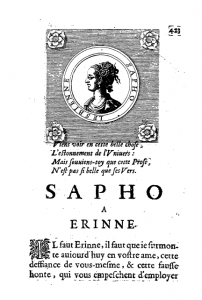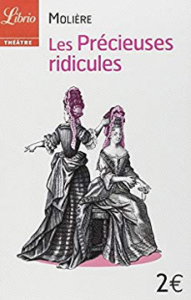‘The Invisible Troupe of Women’: Some Reflections on Historical Women’s Writing
By Dr Helena Taylor, Leverhulme Early Career Research Fellow in French. A post for International Women’s Day and Women’s History Month

When the novelist Marguerite Yourcenar became the first woman to be elected to the Académie française in 1980 she acknowledged in her acceptance speech the ‘invisible troupe of women who should have received this honour before [her]’ and whose ‘ghosts’ she would like to admit. As well as identifying several women writers by name — Mme de Staël, George Sand and Colette — Yourcenar also referred to ‘the women of the ancien régime [the 17th and 18th centuries], the queens of the salons who never dreamt of crossing this threshold; perhaps they feared that doing so would jeopardise their feminine sovereignty.’ (Discours de réception, Jan 1981).

By offering this acknowledgement, she gestures towards the (now well established) need to recover the works of women from the past who have been marginalised within or excluded from the canon: particularly those, who, as Yourcenar goes on to explain, were hugely influential and widely read at their time of writing. To some degree, this work of recovery has since been done for some of these salon women: Madame de Lafayette’s novel, La Princesse de Clèves, is studied for the French ‘Bac’ (A Level) and enjoyed an unintended boost in publicity in 2006 when the then President, Nicolas Sarkozy, questioned its relevance. Other writers of the seventeenth century, such as Madeleine de Scudéry or Madame de Villedieu, have gained attention within academic circles thanks to feminist scholarship, though a seventeenth-century woman writer is yet to make it onto the prestigious exam for the French teaching qualification, the ‘Agrégation’.

It is, however, the second part of what Yourcenar says which most interests me here: how did women writers establish authority in a patriarchal culture? Yourcenar suggests that some of these ‘queens of the salon’ did not seek to enter the all-male domain of the Académie française because to have done so would have threatened their authority, which capitalised on a particular construction of femininity. One of the women she is surely thinking of is the novelist, Madeleine de Scudéry (1607-1701). She hosted a cultural gathering in the reception rooms — the salon — of her house in the Marais in Paris. She was hugely influential as a writer: her works — some of which were co-authored with her brother and appeared under his name — were widely read and translated (into English, German, Italian, Spanish and Arabic). However, the closest she got to being recognised by the Académie française was to be offered a prize for her essay On Glory in 1671.
Taking place on Saturdays, her salon came to be known as the ‘samedis’. These gatherings attracted key philosophers, scientists, writers, and poets of the day. These were polymathic spaces where women of a certain class could, alongside men, read and discuss the latest literature, co-write poetry, probe questions of moral philosophy and debate new scientific discoveries. For instance, Scudéry engages directly with the topical question of the human/animal divide in a short observational essay about her exotic pets, The Story of Two Chameleons, a text we’ve been studying as part of the final-year module ‘Green Matters in Modern Languages and Cultures’. This was written in refutation of the philosopher René Descartes’s theory of the animal-machine and in dialogue with the more ‘scientific’ Anatomical Description of a Chameleon (1669) by Claude Perrault of the Royal Academy of Sciences.
The ‘feminine sovereignty’ came not only from Scudéry’s status as host, but also from the particular philosophy of gender and sociability espoused by the culture of her salon and present in much of her writing. Scudéry’s was not the only or the first female-led salon, but she was the author who reflected most strongly in her work – long novels ‘à clé’, as well as her philosophical dialogues, ‘conversations’ – the social knowledge of the salon world. In these works, she lambasts the restrictions of marriage, represents women in roles of authority and, significantly, reflects on what it means to be an intellectual in a patriarchal society. She advocates women’s education, and criticises constructions of gender that limited women to ornamental roles. Through the character of ‘Sapho’, a nickname amongst her friends and reference to the ancient Greek poetess, Scudéry calls women to overcome the restrictions of their gender: ‘Those who say that beauty is women’s part and that arts and letters and all the liberal and sublime sciences belong to men and that we have no part in them are equally far from both justice and truth.’ (Les Femmes Illustres [Illustrious Women] trans. Karen Newman, Chicago, 2003, p. 137).
However, she also emphasises difference rather than equality by delineating a feminised way of knowing on which her own authority relied, as Yourcenar suggests:
‘a woman may know languages, she may confess to having read Homer, Hesiod, and the excellent works of the illustrious Aristaeus without seeming a pedant; she can even offer her opinion in a modest way, without being aggressive, so that without transgressing what is appropriate for her sex, she can let it be known that she is a woman of wit, knowledge, and judgment.’ (L’Histoire de Sapho, 1654 [The Story of Sapho], Ibid. pp. 23-24).
In the opening of the Two Chameleons, Scudéry puts into practice this modesty: ‘I will not attempt to speak as a physician or as a philosopher, since I am not capable.’ (‘Histoire de Deux Caméléons’, Nouvelle Conversations de la Morale (Paris, 1688), pp. 496-542, my translation).

Her emphasis on difference, and her claims of modesty — however strategic — could be seen as a gesture of compromise, an unthreatening accommodation to male anxiety about women’s power that allowed men to justify women’s exclusions from other domains (such as the Académie française). But this emphasis could also be seen as the opposite, as a way of shifting our understanding of what knowledge looks like and what it meant to be ‘learned’, a proposition for intellectuals, male and female alike: her relationship with what Michèle le Dœuff calls ‘le sexe du savoir’ [‘the sex of knowing’] is therefore complex. Much of her reception has been more essentialising: she was mocked by some of her contemporaries and deemed a ‘précieuse’, that is, ridiculed for her pretensions to knowledge; and only relatively recently have critics begun to take her seriously as a thinker and philosopher as well as as a novelist.

Scudéry’s celebration of feminine traits was not the only approach women used to navigate the patriarchal world of literary culture. Marie de Gournay (1565-1645), some 40 years her senior, and first editor of Montaigne’s Essais, took a different line: she resisted feminised notions of modesty and argued fiercely for the equality of the sexes. Her dense, highly referential, wide-ranging essays demonstrate at every turn her learning, and her anger at her struggle as a woman to be accepted for it. In her key work of feminist theory, L’Égalité des hommes et des femmes (1626) [The Equality of Men and Women], she emphasised that there is no inherent difference between the male and female soul: ‘I am content to make [women] equal to men, given that nature, too, is as greatly opposed, in this respect, to superiority as to inferiority’. She adds: ‘the human animal, taken rightly, is neither man nor woman, the sexes having been made double not so as to constitute a difference in species, but for the sake of propagation alone (Apology for the Woman Writing, trans. Hillman and Quesnel, Chicago, 2003, p. 75, p. 86). Differences are socially constructed and need to be combatted: ‘It is not enough for certain persons to prefer the masculine to the feminine sex; they must also confine women, by an absolute and obligatory rule, to the distaff—yes, to the distaff alone’ (Ibid, p. 75). Her legacy is also marred by misogyny: interpretations of her work have been distracted by her body and its associated prejudices (there was a particular tendency to characterise her as a childless old woman with an unhealthy, pseudo-maternal affection for her cats), such that the full extent of her intellectual contribution is only beginning to be realised.
Equally, we might think of Anne Dacier (1647-1720), 30 years Scudéry’s junior, daughter of a famous scholar of Greek, Tanneguy le Fèvre, and the first woman to translate Homer. Her authority derived from her excelling in a world of knowledge usually gendered as male — Humanist erudition — and her production of learned translations from ancient Greek and Latin. She often used masculine forms of rhetoric, taking what Mary Beard describes as the ‘trouser suit’ approach: the ‘cultural template’ for a powerful person is male, so that adopting male-gendered attributes asserts authority (Women and Power: a Manifesto, London, 2017, pp. 53–4). For instance, Dacier would describe the men who disagreed with her methods of translating Homer in the very misogynous terms used against women: she compared her main opponent, Houdar de la Motte, to a ‘woman who knows little of the beauties of poetry’, likening his representation of the goddess Minerva to a ‘précieuse ridicule’ (Des Causes de la corruption du goût, Paris, 1716 [Of the Causes of the Corruption of Taste], p. 51, p. 477). Dacier’s authority meant that during her lifetime she wasn’t subject to quite the same gendered ridicule as Gournay and Scudéry, but she also fell prey to such criticism after her death: she was described, for instance, as ‘a harpie’ by Augustin-Simon Irailh (Querelles littéraires [Literary Quarrels] Paris, 1761, p. 311).

International Women’s Day 2021 — inclusive, intersectional, and global — shows how far feminist thought and action have progressed since the seventeenth century. Nevertheless, some of the same concerns persist: we are still required to negotiate patriarchal norms and, like the women discussed here, are confronted with different ways for doing so, from Sheryl Sandberg’s call to Lean In to Dawn Foster’s to Lean Out. We still encounter the gendering of knowledge (see for e.g. #ImmodestWomen), restrictions on girls’ education, the challenge of finding a voice and having it heard. As we focus today on pressing global concerns around silencing and invisibility, we might also pause for a moment to summon again the spectre of these ‘ghosts’ and others, invoking what they said — and did — in the context of the challenges still facing us today.
Recent Comments